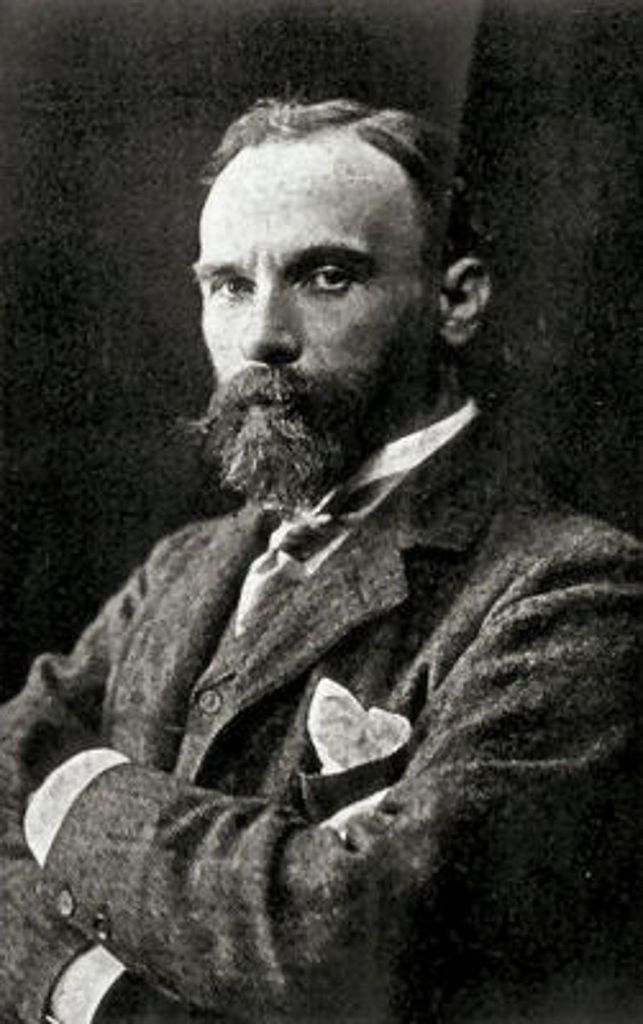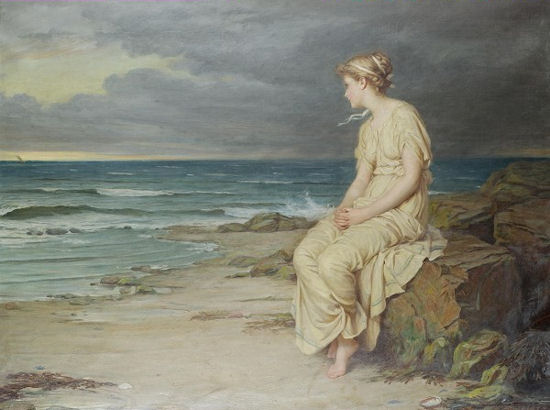
The artist I am looking at in my next series of blogs is the very popular late 19th and early 20th-century British painter, John William Waterhouse, who was best known for painting in the Pre-Raphaelite style, a style which became increasingly popular during the Pre-Raphaelite movement which began in 1848. Waterhouse was a man who, through his paintings, we can see was fascinated by unhappiness, magical worlds and the exciting perils brought about by love and beauty. He was captivated by female beauty and intrigued by the power the women held over men.

Waterhouse was born in Rome on April 6th 1849. The year 1849 was an important year in English art as it was the year that members of the Pre-Raphaelite Brotherhood, which included Dante Gabriel Rossetti, John Everett Millais and William Holman Hunt, were first causing a pandemonium in the London art scene. John William Waterhouse was the first-born child of William Waterhouse and his second wife Isabella Waterhouse (née McKenzie). Both his parents were artists who had exhibited at the Royal Academy and worked in Rome. Waterhouse was given the nickname of “Nino” by his parents. Nino was short for Giovannino or “little John” and this nickname would remain with him throughout his life. When he was five years old his parents left Italy and moved to the London, where they moved into a newly built house in South Kensington, which was near to the newly founded Victoria and Albert Museum. Three years after moving back to England, his mother died of tuberculosis at the age of 36, a disease which, seventeen years later, would take the lives of two of his younger brothers.

Waterhouse’s father remarried in 1860 and at this time he, his new wife and his son lived in Leeds. Waterhouse attended the local school and despite his favourite subject being Roman history, he had hopes of becoming an engineer. By 1870 the family was once again living in London and his father was earning a living by painting portraits assisted by his son. In 1880, at the age of 21, Waterhouse entered the Royal Academy Schools as a probationer in sculpture. His probationary period just lasted for six months, after which he was admitted as a student but he had now begun to concentrate on painting rather than sculpting. It was around this time that he began to exhibit some of his work at the Dudley Gallery and the Society of British Artists.

One of Waterhouse’s early paintings was his 1882 work entitled Undine. Undine was the main character in the German novelist and playwright Friedrich de la Motte Fouqué’s 1811 classic fairy tale, Undine, in which he tells the story of this elemental water spirit, who marries a human in order to gain a soul. Undine’s hair and body shape replicate the vertical flume of water from the fountain we see behind her. This connection between women and water will be repeated many times in Waterhouse’s later works. The female, Undine, was also the one of the first of Waterhouse’s many young female figures.

During the 1870’s Waterhouse completed a number of Orientalist works. One of these works, which he completed in 1873, was his painting, The Unwelcome Companion: A Street Scene in Cairo. The painting was exhibited at the gallery of the Society of British Artists the following year. In 1951, the work was donated it to Towneley Art Gallery in Burnley. Waterhouse later depicted the same woman in the same dress in his work, Dancing Girl. At this time there was a great demand for paintings featuring Near Eastern images. The great French painter, Jean-Léon Gérôme had become a worldwide celebrity for his Orientalist works. Coincidentally, whilst Waterhouse was studying at the Royal Academy Schools in London, Gérôme was also in the city having taken refuge there during the 1870 Franco-Prussian War and had been elected as an Honorary Foreign Academician at the Royal Academy and it is thought that the two artists could have met. The depiction of the woman featured in the painting is quite similar to the females we see in some of Gérôme’s painting featuring the women of Cairo. In this work the woman holds a tambourine and so we must conclude that she is a dancer but she is a mystery as we cannot tell what she is thinking. The architecture, as seen in Waterhouse’s depiction of the arch column we see in the background, derives from the Alhambra Palace in Granada. It is known that Waterhouse had not visited Spain but his family did live close to the South Kensington Museum which housed architectural models of the interior of the Spanish palace and it is here that he probably made sketches.

In 1874, Waterhouse had his first painting accepted for the Royal Academy’s Summer Exhibition. The painting, entitled Sleep and his Half Brother Death refers to Greek mythology and the Greek gods Hypnos (sleep) and Thanatos (death) who were brothers. It is a painting which links sleep and death. Two young men are seen lying on a bed. As our eyes move from the foreground to the background we are moving from life to death. Hypnos in the foreground is bathed in light whereas his brother, Thanatos is enveloped in darkness and from the title of the painting we know that Hypnos represents sleep whereas Thanatos personifies death. Hypnos also can be seen clutching a bunch of poppies from which is derived laudanum and opium for inducing sleep and dreamlike states.
John Arthur Blaikie, a journalist gave a brief critique of this painting in The Magazine of Art in 1886, wrote :
“…The two figures recline side by side on a low couch, beyond which are the columns of a colonnade open to the night and touched with moonlight. The interior is lit by a lamp, whose light streams on the foremost figure, Sleep, whose head hangs in heavy stupor on his breast, and his right hand grasps some poppies. By his side lies Death in dusky shadow, with head thrown back, and the lines of the figure expressive of easeful lassitude. At his feet is an antique lyre, while immediately in the foreground is a low round table… The two figures are both young, and the beauty of youth belongs to one as much as to the other… the strange likeness and unlikeness of the recumbent figures…”
The reason why twenty-five-year-old Waterhouse decided to paint this disturbing scene was probably because it was shortly after his two younger brothers died of tuberculosis.

At the 1875 Royal Academy Exhibition Waterhouse submitted his work Miranda. This marked the first time he depicted a heroine from a Shakespeare play, a thing he would do on a number of occasions later in his life. Miranda was the daughter of Prospero in the play, The Tempest. She was banished to the Island along with her father at the age of three, and in the subsequent twelve years has lived with her father and their slave, Caliban, as her only company In the depiction we see the young women, seated gracefully on a rock, gazing out at a ship on the horizon which she hopes is bringing Ferdinand, her future lover and rescuer, to the land where she has been exiled. But then the storm comes……..
Miranda in Waterhouse’s painting is not dressed in Shakespearean costume but wears classical clothes replicated from ancient Greece sculpture. Cords cross between her breasts and encircle her waist with an overfold of rumpling fabric. The hairstyle Waterhouse has given his female is also of classical style with two bands of circling ribbon, the ends of which flutter in the strengthening winds of the approaching storm.

Forty-one years later, in 1916, a year before his death, Waterhouse once again depicts Miranda in a painting. Whereas the earlier painting has Miranda looking out at Ferdinand’s ship which is a mere dot on the horizon, this painting depicts a later part of the Shakespearean story. The storm or tempest has come and Ferdinand’s ship is much bigger and closer to the rocky shoreline where Miranda sits upon the rock. The ship is being battered by huge green and purple waves topped with white foam. The gale force winds whip through Miranda’s clothes and hair. In this work Miranda’s clothes are no longer of classical Greek style but now resemble clothes worn at the time of Shakespeare’s 1612 play. There is something much stronger about this latter Miranda with her fiery red hair loosened and flowing and the vivid colouring of her clothes which give her a much bolder aura than her earlier reflective and inhibited counterpart of 1875.

The third year Waterhouse had a painting accepted for the Royal Academy’s Summer Exhibition was 1876. His painting, entitled After the Dance, was given a favourable hanging position on the wall of the gallery, just above eye-level, often referred to as “on the line” as this was the level at which most observers could best see the works of art. To achieve this positioning was an acknowledgement that the hanging committee looked upon him as an up-and-coming talent. This is a work quite clearly influenced by the great Lawrence Alma-Tadema who also had a painting with the same title in that year’s exhibition, although his work depicted a voluptuous nude bacchante lying asleep after wild revelry. This large work (76 x 127cms) depicts a Roman interior, in which we see part of the atrium and a glimpse into the court beyond. The main figures are a young boy and a young girl, both dancers who are very tired after dancing and are both resting on cushions, the boy is sitting up, clutching a wilting flower, and the girl is drowsily stretched on the tessellated floor with a tambourine lying alongside her. In the left background we can see a group of adult minstrels seated on a marble bench.

One holds an aulos or tibia which was an ancient Greek double-piped wind instrument, while the other rests his arm upon his lyre. One has to question the mood of the painting. The title, After the Dance, suggests merriment and yet before us we see two exhausted children and as a backdrop there is a very dark painting depicting a funeral procession. The expression on the children’s faces is not one of joy and excitement but one of exhaustion and a hint of melancholy. Maybe Waterhouse wanted his painting to be a critical comment with regards child labour.
…………………………….to be continued

I have several prints of John William waterson. I adore them some of my friends who don’t understand art have called then morbid.